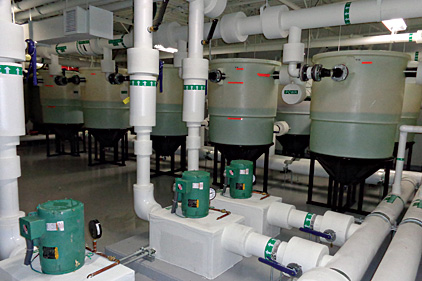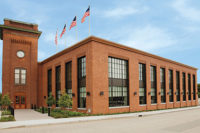Thomas Reilly, P.E., already had a wealth of experience working on LEED projects when he and his firm, Salem Engineering, were approached to design plasma, laser and waterjet manufacturer Hypertherm’s facility in Lebanon, N.H.
Reilly, a principal at the South Burlington, Vt.-based firm, initially was concerned about how his team could reach the LEED requirements in a manufacturing plant that uses copious amounts of energy. Middlebury, Vt.-based Bread Loaf Construction Vice President of Mechanical Systems John Johnston, P.E., worked with the owners to develop the mechanical and electrical systems.
“We advised the customer that it was going to be harder to achieve certain energy guidelines because of the high energy use throughout the plant,” says Reilly, who was the onsite MEP engineer. “They build plasma cutters so they are constantly testing the power supply.”
Hypertherm’s Lebanon operation is the company’s 12th facility located in the Upper Valley region of New Hampshire and Vermont. The Upper Valley extends from the southern border of Cornish, N.H., to Windsor, Vt. It includes the cities of Lebanon and Hanover, N.H., and is 60 miles northwest of the state capital of Concord.
The 160,000-sq.-ft. plant sits alongside Interstate 89 and includes administration offices, research-and-development areas, engineering space and training rooms. The project design started in 2010 and the plant went fully online in 2013. Hypertherm expects to add up to 500 new jobs because of added operational capacities. When the design process started expectations were to receive 50 LEED points and achieve LEED Silver status.
But as the design process rolled along, Salem Engineering, Bread Loaf, LEED administrator Cx Associates and Hypertherm worked together and found more innovative solutions to enhance efficiencies. When the dust settled and the U.S. Green Building Council tallied up the points, the Lebanon facility was credited with 62 LEED points and awarded LEED Gold status. In addition, it became the first facility in New Hampshire to receive a Gold designation (the state doesn’t have a Platinum building).
“We are grateful to the amazing team of professionals who helped us stay true to our core values and environmental goals by guiding us through this process,” says Barbara Couch, Hypertherm’s vice president of corporate social responsibility. “The end result, coupled with the LEED Gold announcement, is more than we ever could have hoped for.”
Picking up points
The Lebanon facility accumulated LEED points in many different areas. Some of the major overall benchmarks hit were:
- The diversion of 90% of the construction waste from landfills;
- An overall 47% reduction of water use; and
- A 100% reduction in manufacturing and testing process water through a water recycling and filtration system.
Reilly launched Salem Engineering in 1989 and the company’s first project was designing a waste oil recycling facility in Meriden, Conn. The system would take in contaminated fluids and separate the water from the oil. The water recycling process at Hypertherm doesn’t stray from what the company designed 25 years ago.
“This was just one more variant of a basic water purification system,” Reilly says.
The process starts when a Hypertherm plasma cutter, which Reilly notes can “cut through 6 in. of stainless steel like it is butter,” begins its cutting process. The plasma is, in essence, hotter than the surface of the sun and blows a fine curve through the metal.
Reilly explains the company can’t afford to have a person continually placing and removing slices of steel day and night, so it devised an automated process that is similar to a record player.
“A plate sits in a bath of water and spins. The plasma melts, but it doesn’t blow away the metal,” he says. “The metal spins out of the way and then cools in the water. This water bath is absorbing all the energy of the plasma torch.”
Reilly made sure the 12 plasma cutting stations were connected so all the water gets collected in a common 3,000-gal. sump pump. The water is pumped into a series of 500-gal. settling tanks where the metal and any other solids are sifted out.
“We arranged the tanks so the first few tanks are quite warm and could be cooled directly by tower water,” Reilly explains. “It goes through a large tank and booster pumps to get back to utility-level pressures. It is then sent back to the cutting stations.”
All the water comes from the city of Lebanon, but with the recycling system, Hypertherm saves the more than 70,000 gal. of municipal water per day.
“Before, Hypertherm would let the water overflow and go into the sewer,” Reilly says. “We said, ‘We can’t be doing that anymore,’ and we put together this significant system.”
The plant received other LEED credits because the design protected the region’s wetlands and maintained 58% of the site as vegetated open space. The facility uses 25% less energy compared to a baseline building of similar use and climate category.
Bread Loaf and Salem Engineering also made sure the Hypertherm facility was well-insulated and had an air-tight building enclosure. The building also received LEED credits for its skylights, strategically placed windows for day lighting and its high-efficient mechanical systems outfitted with a plethora of controls for building users to monitor energy usage.
Rainwater harvesting
Hypertherm elected to install a rainwater harvesting system for the facility, which proved to be quite a challenge for Reilly to design because of the size and scope. The facility covers the length of about two football fields. Beyond the size, Reilly and his crew chose to use a brand-new design tactic for this particular project.
“The building is so big that the rainwater collection system off the roof was quite a challenge,” Reilly says. “We ended up using a siphoned drainage system. We had to run our roof drainage piping level across major sections of the building in order to meet up at the correct spot of the civil engineer’s water retention systems. Rain gardens are located along the office portion of the building to serve that roof drainage need.
Reilly continues: “The building was so large that we couldn’t accommodate for the gravity flow needed by the civil engineering systems. We were a little scared because we’d never done that before. But, we worked with the people from Zurn and used their computer modeling programs to verify that our piping was going to meet the desired intent.”
Even after Reilly and Zurn teamed up to complete the rainwater harvesting system, there still were hurdles that had to be cleared before construction could begin.
“We then had to work with the code officials,” Reilly states. “They were apprehensive on approving a siphonic drainage system. We had to send them a letter proving that the system was designed by professional engineers.”
Other easy LEED credits came in the form of Kohler low-consumption toilets, Halsey Taylor water coolers, Sloan Valve showerheads and low-flow Zurn urinals outfitted in the restrooms throughout the manufacturing areas, fitness center, office space accommodations and cafeteria.
Reilly designed a water-cooled ventilation system instead of a more standard air-cooled version, which will recover energy and transfer it to other parts of the facility. The ventilation is de-coupled from the air-conditioning system.
“In the parts of the building that have less ventilation, we’re recovering Btu,” Reilly states. “We’re transferring them over to areas where the building has high-ventilation needs.”
Reilly says the design team wanted an ace in the hole for the LEED inspectors when they came to tour the Hypertherm facility.
“The computer room is tied into the condenser-water system,” Reilly says. “We wanted to have a trump card. So we set the system up so it could run off of city water. This entails a switchover from closed-loop cooling to a backflow-protected connection to the building’s cold water system and emergency discharge to drain for the limited use duration.”
The Hypertherm facility hit new eco-friendly benchmarks for the state of New Hampshire. It also provided Reilly chances to explore how to reword trusted designs in new commercial environments.
“This project explored new opportunities for using proven systems in unique settings to help the customer meet its energy needs,” he says. “Having a great construction and ownership team made the process flow smoothly and helped the project achieve its budget and schedule, and energy usage goals.”


